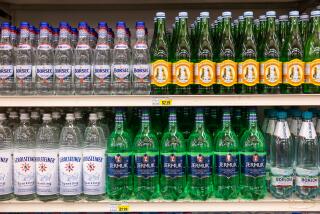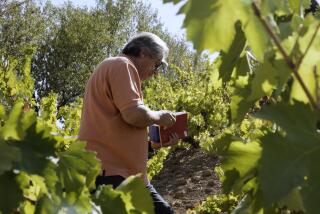Why one L.A. wine expert has Georgia on his mind. The country, that is
Where wine is concerned, Taylor Parsons is almost never gobsmacked. The former wine director at République, the Hancock Park restaurant, author of one of the broadest, most idiosyncratic wine programs in the city, has managed the programs in some of L.A.’s finest restaurants, from Spago to Mozza. He has tasted wine from all over the world, and has an encyclopedic knowledge of the vinous arts such that the rest of us can only dream about. It’s hard to throw him off his game.
But Georgia — the country, that is — threw him off his game. A 2015 wine tour to this former Soviet republic in the eastern reaches of Europe left him both discombobulated and thrilled.
For the record:
12:51 a.m. Nov. 17, 2024A photo caption below says the vineyard was planted by Kakha Berishvili and is outside Artana, Georgia. The rows of vines are at the Agrarian Research and Development Center, where hundreds of cultivars are propagated in an effort to safeguard Georgia’s ampelographic heritage against genetic erosion.
“The flavors and textures of the wines were unlike anything I’ve ever tasted,” says Parsons, 37, who like many sommeliers makes regular trips to the wine regions of France, Germany and Spain. “Very little of what they’re doing is reasonable by Western standards, but the wines are so expressive. And it’s all set in an incredibly ancient winemaking tradition where wine has penetrated deeply and completely into the culture, in ways that I had never experienced before.”
That is what happens when the country you’re visiting is the oldest wine region on Earth, surpassing 8,000 vintages — a country with as many as 100,000 micro-wineries, where it’s nearly impossible not to know someone who makes wine, whether a neighbor or friend or family member.
It’s a country where much of the wine is made in a traditional method that is ancient and seemingly unchanged, typified by the use of large clay vessels called qvevri, which are buried underground and filled with grapes in a process that seemed, to Parsons, at once archaic and yet strangely transformative and profound. European varieties like Riesling or Cabernet are all but unheard of.
The flavors and textures of the wines were unlike anything I’ve ever tasted
— Taylor Parsons
Instead, there are 500 indigenous varieties, with virtually unpronounceable names that amount to a thicket of consonants, names such as Tsitska and Mtsvane and Otskhanuri Sapere.
After decades of isolation, Georgia’s wine industry has, in the last half-decade, experienced its first post-communist curtain call, spurred in part by a conflict with Russia that forced growers to seek other markets, resulting in a surge in global interest.
In California, small importers such as Chris Terrell and the Blue Danube Wine Co. (both in the Bay Area), have introduced the wines, and their reception in wine circles has been similar to what Parsons experienced, or Alice Feiring, a New York wine writer as worldly as Parsons. She was similarly floored, so much so that she penned a fascinating book on Georgian juice called “For the Love of Wine.” “I had never been exposed to a country where wine was so profoundly woven into customs and daily life,” she wrote.
And though there are a handful of large industrial wineries (mostly supplying Russia and its former dominions), the small family winery tradition is still powerful, and vouchsafes the wines as authentic, honest and unsullied. As Feiring puts it, “This is a land where flavor has not been bred out.”
Georgia is closer to Istanbul and Tehran than to Paris or Madrid. It stretches from the Black Sea to Russia and Azerbaijan, and lies between the double spine of the Caucasus Mountains, which form a northern and southern border, making the country geographically and viticulturally isolated.
It is, quite literally, a crossroads: Persians, Byzantines, Russians, Greeks and Turks have taken turns running over the region. And yet, despite its role as link between East and West, its complex geography has resulted in a distinctive food and wine culture that is renowned in Eastern Europe, so much so that Russian poets, from Pushkin to Osip Mandelstam, wrote odes to the land’s bounty.
The country has more than 500 indigenous grape varieties, though two, the white Rkatseteli and the red Saperavi, are predominant. While both make compelling wines, other varieties such as Mtsvane, Tsitska, Tsolikouri, Chinuri and Kisi are garnering attention.
But whatever variety is used, the wines are irrevocably transfigured by the use of qvevri (pronounced “kwev-ri”), large clay urns that are buried underground in cellars, filled with grapes that are left to ferment naturally, usually with skins and seeds, and sometimes stems, to mingle with the juice. With its elegant curves and ancient, Romanesque geometry, the qvevri is the symbol of Georgian winemaking, and the resulting flavors, according to Parsons, are unlike any others in wine.
“The flavors of most French wines are sort of in the universe of the orchard,” says Parsons, “apple and citrus and stone fruits. That’s sort of true here, but the flavors aren’t necessarily fresh; it’s more like preserves, like poached or fermenting fruit.” Dried fruit flavors are common, from apricot to apple and golden raisin, sometimes with a slightly volatile quality. “They can be a little ferment-y,” admits Parsons, “like fruit that’s starting to go a bit overripe on the counter.”
But their time in qvevri transforms these wines texturally. The amber-colored whites, loaded with acid and tannin, feel unusually stolid and weighty, saturating the palate, and the reds are equally, preternaturally replete.
“These wines are fundamentally different than most of the wines we encounter on a daily basis,” says Parsons. “They expand our notions of what’s possible.”
Where to find Georgian wines:
Georgian wines are still relatively rare in the marketplace, but they’re getting easier to find — Chris Terrell Wines, the Blue Danube Wine Co. and the Washington area’s Georgian Wine House have been especially tireless in spreading the word (in California, Blue Danube sells direct as well).
In Los Angeles, K&L Wine seems to have the best selection, but Lou Wine Shop, Domaine LA and Silver Lake Wine always have a few on hand. As for restaurants, Night+Market Song and Gjelina have a selection on their wine lists.
Three Georgian wines to try, selected by Taylor Parsons:
2015 Niki Antadze Rkatsiteli No. 1 (about $22)
Antadze makes two Rkatsitelis, one with and one without skin contact — this is the latter. It’s bright and zesty, as if every part of the lemon were represented here, with a really appealing pithy bitterness. A perfect lunchtime wine — bring on the spring salads.
2015 Iago’s Wine Chinuri (about $20)
Superb winemaking on display — it’s no wonder that Iago Bitarishvili is one of the stars of artisanal Georgian winemaking. Layered aromatics of green pears, bay, almond and lemon give way to a delicacy on the palate that defies expectation. Gorgeous balance of acidity and tannin.
2004 Shavnabada Mtsvane (about $35)
As delicious as it is unusual. Aged in qvevri for 11 years before bottling. Waxy, dense and totally intriguing — it tastes of walnuts and quince, honeycomb and dusty old books. Loads of tannin with plenty of freshness.
More to Read
Eat your way across L.A.
Get our weekly Tasting Notes newsletter for reviews, news and more.
You may occasionally receive promotional content from the Los Angeles Times.










